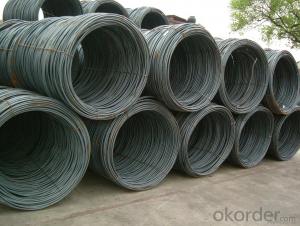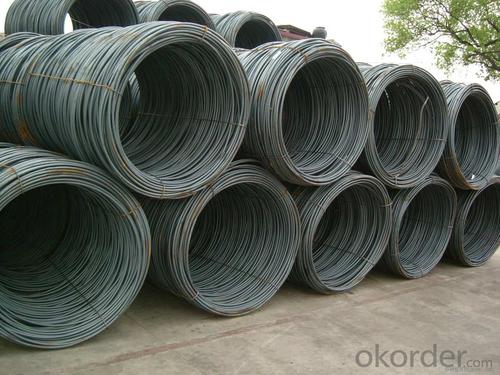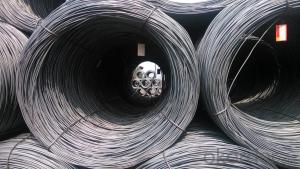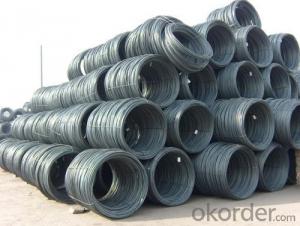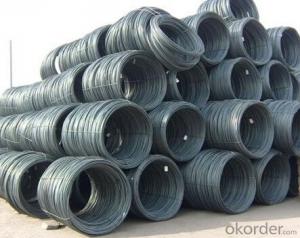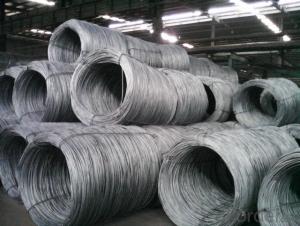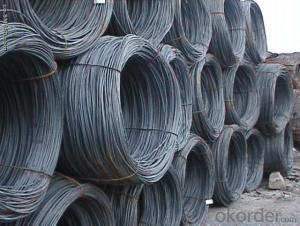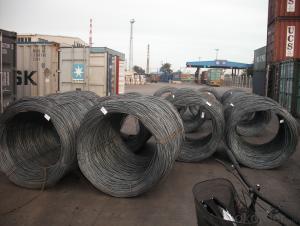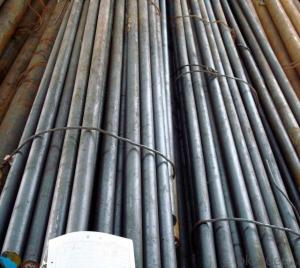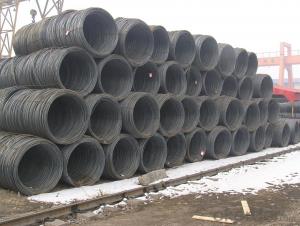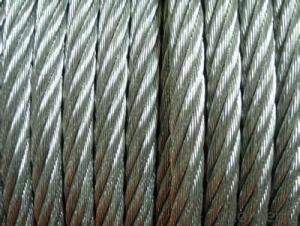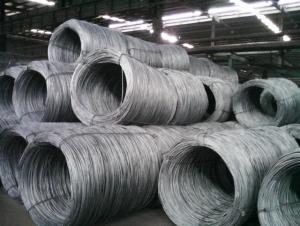Hot Rolled Round Rod Coil
- Loading Port:
- China Main Port
- Payment Terms:
- TT OR LC
- Min Order Qty:
- -
- Supply Capability:
- -
OKorder Service Pledge
OKorder Financial Service
You Might Also Like
Specifications of Hot Rolled Wire Rod:
Steel Grade: Q195/235, SAE1006-1018B Standard: ASTM, GB
Diameter: 5.5mm, 6.5mm, 7mm,8mm,9mm,10mm,12mm,14mm
Type: in coil, coil weight around 2MT Alloy or Not: Alloy
Technique: Hot Rolled Place of Origin: China Mainland
Surface: round, no twisted, light and smooth
Chemical Composition: (Please kindly find our chemistry of our material based on Q195、Q235A and Q235B as below for your information)
| Trademark | Rank | Chemical composition (quality score) % | ||||
| C | Si | Mn | S | P | ||
| ≤ | ≤ | ≤ | ||||
| Q195 | 0.06-0.12 | 0.30 | 0.25 | 0.050 | 0.045 | |
| Q235 | A | 0.14-0.22 | 0.30 | 0.30-0.65 | 0.050 | 0.045 |
| Q235 | B | 0.12-0.20 | 0.30 | 0.30-0.70 | 0.045 | 0.045 |
Usage and Applications of Hot Rolled Wire Rod:
After hotrolled the products shaped into coil and delivery as finished product, including round, square, rectangular, hexagonal and so on. Since most of the products are round, it is generally called wire rod. Carbon steel wire rod is widely used in construction and manufacturing. Carbon steel wire rod is mainly used for reinforcement of reinforced concrete and welded structure or reprocessed (roberts , nail, etc.) materials, especially used to produce wire drawing, welding electrode, nails, spring, electronic, precise machinery parts and so on.
Packaging & Delivery of Hot Rolled Wire Rod:
Packaging Detail: products are packed in coil, each coil weight around 2 MT, and then shipped by container or bulk vessel
Delivery Detail: within 45 days after received deposit or LC.
Label: to be specified by customer, generally, each bundle has 1-2 labels
Trade terms: FOB, CFR, CIF
- Q: What are the requirements for steel wire rod used in cable-stayed bridge wire strands?
- The requirements for steel wire rod used in cable-stayed bridge wire strands are typically stringent due to the critical nature of these components in ensuring the safety and structural integrity of the bridge. Here are some of the key requirements for steel wire rod used in cable-stayed bridge wire strands: 1. Material Composition: The steel wire rod must be made from high-quality, high-strength steel with specific chemical composition requirements. This is to ensure the wire's ability to withstand the loads and stresses it will experience in the cable-stayed bridge. 2. Tensile Strength: The wire rod must have a minimum tensile strength that meets the design requirements of the cable-stayed bridge. This ensures that it can withstand the tension forces exerted on it without deformation or failure. 3. Ductility: The steel wire rod must possess sufficient ductility to allow for bending and shaping without fracturing or losing its strength properties. This is important during the fabrication and installation processes of the wire strands. 4. Uniformity and Consistency: The wire rod should have uniform and consistent material properties throughout its length. This is crucial to ensure consistent performance and behavior of the wire strands under various loading conditions. 5. Surface Quality: The surface of the wire rod must be smooth and free from defects such as cracks, scratches, or other surface irregularities. This is necessary to prevent stress concentration points or potential failure initiation sites. 6. Dimensional Accuracy: The wire rod should meet specific dimensional tolerances to ensure proper fit and compatibility with the cable-stayed bridge design. This includes diameter, roundness, and straightness requirements. 7. Corrosion Resistance: The wire rod must possess good corrosion resistance properties to withstand exposure to environmental conditions, including moisture, humidity, and chemicals. This helps to ensure the long-term durability and safety of the wire strands. 8. Certification and Testing: The steel wire rod used in cable-stayed bridge wire strands must be produced by reputable manufacturers and should be accompanied by relevant certifications and test reports. These documents provide assurance that the wire rod meets the specified requirements and has undergone necessary quality control measures. It is important to note that specific project requirements and design standards may vary, and the above requirements may not be exhaustive. Consulting the applicable design codes and specifications for cable-stayed bridges is essential to ensure compliance with the project-specific requirements.
- Q: What are the different surface finishes of steel wire rod available?
- The different surface finishes of steel wire rod available include black, pickled and oiled, galvanized, and coated with zinc or other protective coatings.
- Q: What are the main factors influencing the choice of steel wire rod payment terms?
- There are several main factors that can influence the choice of payment terms for steel wire rod. One of the primary factors is the financial stability and creditworthiness of the buyer. If the buyer has a strong financial position, the seller may be more willing to offer favorable payment terms, such as longer payment periods or installment payments. On the other hand, if the buyer has a poor credit history or financial instability, the seller may require stricter payment terms, such as upfront payment or shorter payment periods. The market conditions and competition can also impact the choice of payment terms. In a highly competitive market with multiple suppliers, the seller may need to offer more flexible payment terms to attract buyers. This could include options like deferred payment or payment upon delivery. Conversely, in a market with limited suppliers or high demand, the seller may have more leverage and can dictate stricter payment terms. The nature of the business relationship between the buyer and seller is another crucial factor. If the buyer and seller have a long-standing relationship with a history of successful transactions, the seller may be more willing to offer favorable payment terms as a gesture of trust and loyalty. Additionally, the volume and frequency of purchases can also influence the payment terms. Buyers who consistently purchase large quantities of steel wire rod may have more negotiating power and be able to secure more favorable payment terms. Lastly, external factors such as economic conditions, currency fluctuations, and government regulations can also impact the choice of payment terms. In times of economic uncertainty or currency volatility, sellers may be more cautious and require stricter payment terms to mitigate their risk. Similarly, government regulations related to international trade or finance can also affect the choice of payment terms. Overall, the main factors influencing the choice of payment terms for steel wire rod include the financial stability of the buyer, market conditions, the nature of the business relationship, and external factors such as economic conditions and government regulations.
- Q: What is the annealing process for steel wire rod?
- To enhance the physical and mechanical properties of steel wire rod, the annealing process is employed. This method consists of heating the rod to a specific temperature and gradually cooling it. It is commonly utilized to decrease the hardness of the steel wire rod, increase its ductility, and improve its machinability. The annealing process commences by elevating the temperature of the steel wire rod above its critical temperature, which generally falls between 800°C and 900°C (1472°F and 1652°F). This particular temperature is necessary for the reconfiguration of the steel's crystal lattice structure. Once the rod reaches the desired temperature, it is maintained at that level for a specific period to ensure the complete transformation of the steel's microstructure. Following the soaking phase, the steel wire rod is gradually cooled to room temperature. This gradual cooling process, also known as controlled cooling, is imperative to prevent the occurrence of stress and cracks in the material. The rate of cooling relies on the specific steel grade and desired properties, and it can be achieved through various methods, including air cooling, furnace cooling, or water quenching. The annealing process for steel wire rod yields numerous advantageous effects on the material. It aids in alleviating internal stresses and enhancing the rod's ductility, enabling it to be bent, shaped, or formed without fracturing. Additionally, annealing improves the steel's machinability, facilitating the cutting, drilling, or shaping of the wire rod during subsequent processing. Moreover, annealing also enhances the rod's electrical conductivity and magnetic properties, rendering it suitable for a variety of applications in the electrical and electronics industries. To summarize, the annealing process for steel wire rod encompasses heating the rod to a specific temperature above its critical temperature, maintaining it at that temperature for a specific duration, and subsequently cooling it gradually. This process is vital for enhancing the steel's physical and mechanical properties, such as reducing hardness, increasing ductility, and improving machinability.
- Q: How is steel wire rod used in the production of wire ropes for ski lifts?
- Steel wire rod is an essential component in the production of wire ropes for ski lifts. The wire rod serves as the raw material from which the wire ropes are manufactured. To begin with, the steel wire rod is carefully selected for its specific properties, such as strength, durability, and flexibility. These characteristics are crucial for ensuring the wire ropes can withstand the heavy loads and constant usage associated with ski lift operations. Once the appropriate steel wire rod is obtained, it undergoes a series of processes to transform it into wire ropes. The wire rod is first cleaned and then heated to a specific temperature to improve its malleability. It is then passed through a series of dies to gradually reduce its diameter and shape it into a continuous length of wire. Next, the individual wires are twisted together to form strands. This twisting process, known as stranding, can vary in configuration depending on the desired strength and flexibility of the wire rope. The strands are then compacted and laid together around a central core, forming the final wire rope structure. The use of steel wire rod in the production of wire ropes for ski lifts offers several advantages. Firstly, steel is known for its high tensile strength, allowing the wire ropes to support heavy loads and provide a safe transportation system for skiers. Additionally, the durability of steel ensures that the wire ropes can withstand the harsh weather conditions and constant exposure to extreme temperatures on mountain slopes. Furthermore, the flexibility of steel wire rod allows the wire ropes to bend and conform to the pulleys and sheaves used in ski lift systems, ensuring smooth and reliable operation. This flexibility is vital in preventing any sudden failure or damage to the wire ropes during their continuous usage. In conclusion, the use of steel wire rod in the production of wire ropes for ski lifts is paramount to ensure the safety, reliability, and durability of these transportation systems. The properties of steel, such as its strength and flexibility, make it an ideal material for constructing wire ropes that can withstand the demanding conditions of ski lift operations.
- Q: How is steel wire rod used in the manufacturing of wire mesh for filtration?
- Steel wire rod is used in the manufacturing of wire mesh for filtration as it serves as the raw material for producing the wire mesh. The steel wire rod is first drawn into thin wire strands, which are then woven or welded together to form the mesh structure. This mesh provides the necessary strength, durability, and flexibility required for filtration applications, such as removing impurities or separating particles in various industries like water treatment, automotive, and aerospace.
- Q: How are steel wire rods tested for quality control?
- Steel wire rods are tested for quality control through a series of rigorous procedures to ensure that they meet the required standards and specifications. The testing process involves various stages that evaluate the physical, mechanical, and chemical properties of the wire rods. Firstly, the wire rods undergo visual inspection where they are examined for any visible defects such as surface cracks, irregularities, or deformities. This step helps in identifying any visual flaws that may affect the overall quality of the wire rods. Next, the wire rods are subjected to dimensional measurements to verify their diameter, length, and straightness. This ensures that the wire rods meet the specified tolerances and are within the acceptable limits. Mechanical testing is then performed to assess the strength and durability of the wire rods. Tensile strength tests are conducted to measure the maximum load a wire rod can bear before breaking. This test determines the material's ability to withstand external forces and is crucial in assessing its overall quality. Chemical analysis is another critical aspect of quality control testing. Wire rods are tested for their chemical composition to ensure that they contain the required elements in the specified proportions. This analysis helps in verifying the material's suitability for its intended application and ensures that it meets industry standards. Furthermore, non-destructive testing methods like ultrasonic testing or magnetic particle inspection may be utilized to detect internal flaws or defects that may not be visible to the naked eye. These testing techniques help in identifying any hidden issues that could compromise the quality of the wire rods. Overall, the quality control process for steel wire rods involves a combination of visual inspection, dimensional measurements, mechanical testing, chemical analysis, and non-destructive testing. By adhering to these strict quality control measures, manufacturers can ensure that their wire rods meet the required standards and provide reliable and high-quality products to their customers.
- Q: How does the elongation of steel wire rod vary with different heat treatment processes?
- The elongation of steel wire rod is influenced by different heat treatment processes. Heat treatment involves subjecting the steel wire rod to specific temperatures and cooling rates to alter its structure and properties. One common heat treatment process for steel wire rod is annealing. During annealing, the wire rod is heated to a high temperature and then slowly cooled. This process relieves internal stresses and allows for the formation of a more uniform and ductile microstructure. As a result, the elongation of the steel wire rod typically increases after annealing. The increased elongation is due to the reduction in brittleness and the improved ability of the material to deform without fracturing. On the other hand, another heat treatment process called quenching and tempering involves rapid cooling followed by reheating and slow cooling again. Quenching hardens the steel wire rod, making it stronger and more resistant to deformation. However, this process can also make the material more brittle, reducing its elongation. The subsequent tempering process relieves some of the brittleness while maintaining the strength, resulting in a moderate elongation. In summary, the elongation of steel wire rod varies with different heat treatment processes. Annealing increases elongation by improving ductility and reducing brittleness, while quenching and tempering can result in a moderate elongation by balancing strength and brittleness. The specific heat treatment process chosen for steel wire rod depends on the desired mechanical properties and performance requirements for its intended application.
- Q: How is steel wire rod used in the manufacturing of wire forms for filtration systems?
- Steel wire rod is vital in the production of wire forms for filtration systems. It serves as the main raw material for creating wires of different strengths and diameters that are used in specific forms for filtration systems. The manufacturing process begins with the careful selection of the steel wire rod based on its composition, mechanical properties, and desired characteristics. This guarantees that the wire rod is suitable for the filtration system's requirements, such as corrosion resistance, high tensile strength, and durability. Once the suitable steel wire rod is chosen, it undergoes a series of manufacturing steps to turn it into wire forms for filtration systems. The wire rod is first cleaned and descaled to eliminate impurities and surface contaminants that could impact its performance. It is then heated to a specific temperature to make it more malleable and easier to shape. Next, the heated wire rod is passed through a series of dies or molds that give it the desired shape and dimensions for the wire forms used in filtration systems. The wire may be drawn through multiple dies to achieve the necessary diameter and strength for effective filtration. After shaping, the wire forms undergo additional processes like annealing, which involves heating and slowly cooling the wire to relieve stress and enhance its ductility. This step ensures that the wire forms can withstand the demands of filtration systems, such as high pressure or continuous use. Once the wire forms are manufactured, they can be further processed or assembled into complete filtration systems. For instance, the wire forms may be welded or joined together to create mesh screens or filter elements, which are then integrated into the overall design of the filtration system. In conclusion, steel wire rod plays a vital role in the production of wire forms for filtration systems. Its versatility, strength, and ability to be shaped into various forms make it an ideal material for manufacturing wires that meet the specific requirements of filtration systems. Whether it is for removing contaminants from liquids or gases, steel wire rod ensures the durability and effectiveness of filtration systems in a wide range of industries.
- Q: How is steel wire rod used in the manufacturing of reinforcement bars?
- Steel wire rod is used in the manufacturing of reinforcement bars by being transformed into a continuous coil through a series of processes such as hot rolling, cooling, and surface treatment. This coil is then further processed to obtain the desired diameter and shape of reinforcement bars, which are widely used in construction projects to enhance the tensile strength and durability of concrete structures.
Send your message to us
Hot Rolled Round Rod Coil
- Loading Port:
- China Main Port
- Payment Terms:
- TT OR LC
- Min Order Qty:
- -
- Supply Capability:
- -
OKorder Service Pledge
OKorder Financial Service
Similar products
Hot products
Hot Searches
Related keywords
